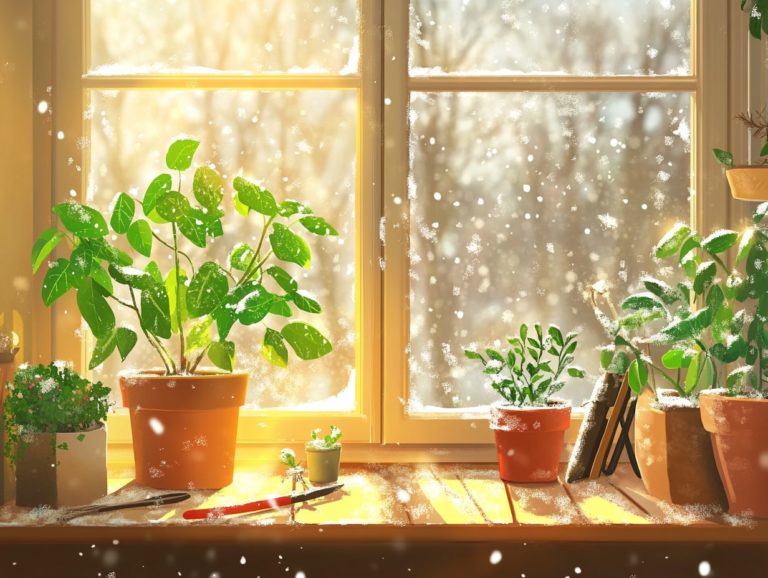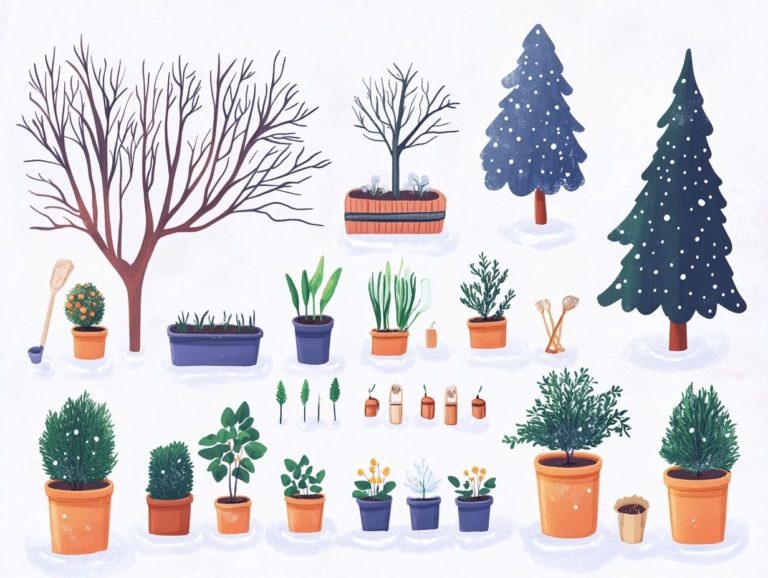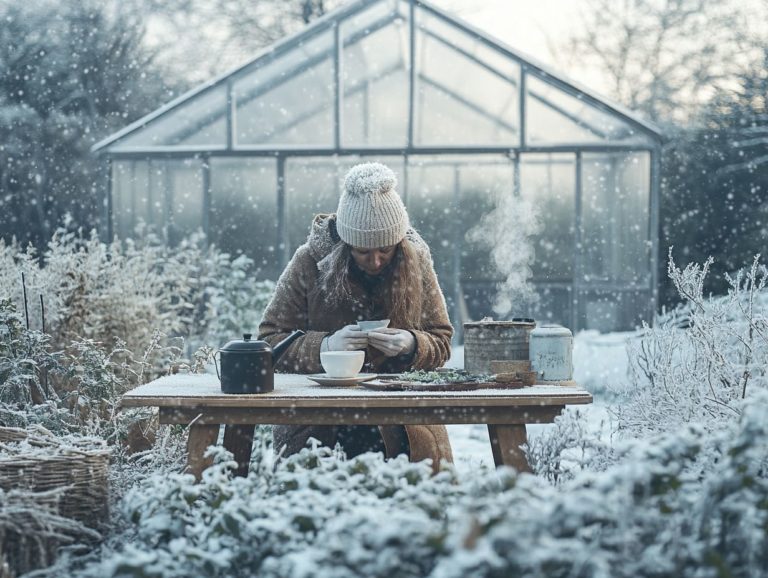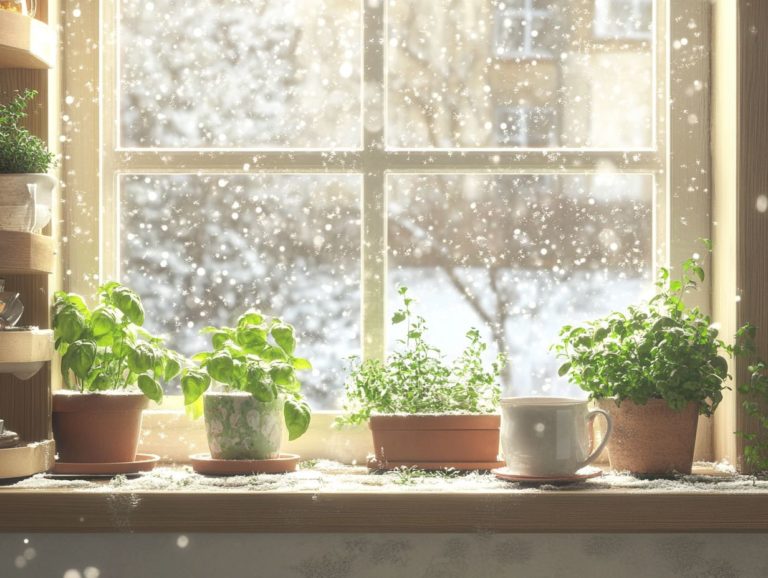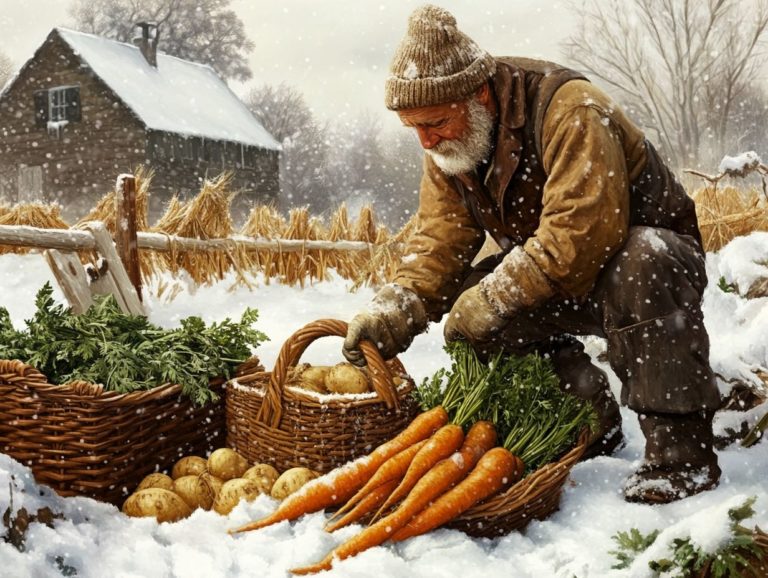Winter Gardening for Small Spaces
Winter gardening might not be the first thing that comes to mind, but it presents an abundance of benefits, particularly for those navigating limited space.
Embrace the joy of fresh produce even in the colder months while uncovering techniques that will elevate your gardening game.
From selecting cold-hardy plants to employing container and vertical gardening methods, this guide equips you with the essentials for winter gardening.
Transform your compact area into a flourishing winter haven brimming with vibrant greenery and delightful harvests! Start your winter gardening journey today for a vibrant harvest tomorrow!
Contents
- Key Takeaways:
- Benefits of Winter Gardening
- Choosing the Right Plants for Winter Gardening
- Preparing Your Garden for Winter
- Winter Gardening Techniques
- Harvesting and Storing Winter Produce
- Tips for Enjoying Your Winter Garden
- Frequently Asked Questions
- What is winter gardening for small spaces?
- Why should I try winter gardening for small spaces?
- What are some popular plants for winter gardening in small spaces?
- Do I need any special equipment for winter gardening in small spaces?
- How often should I water my winter garden in a small space?
- What are some tips for successful winter gardening in small spaces?
Key Takeaways:
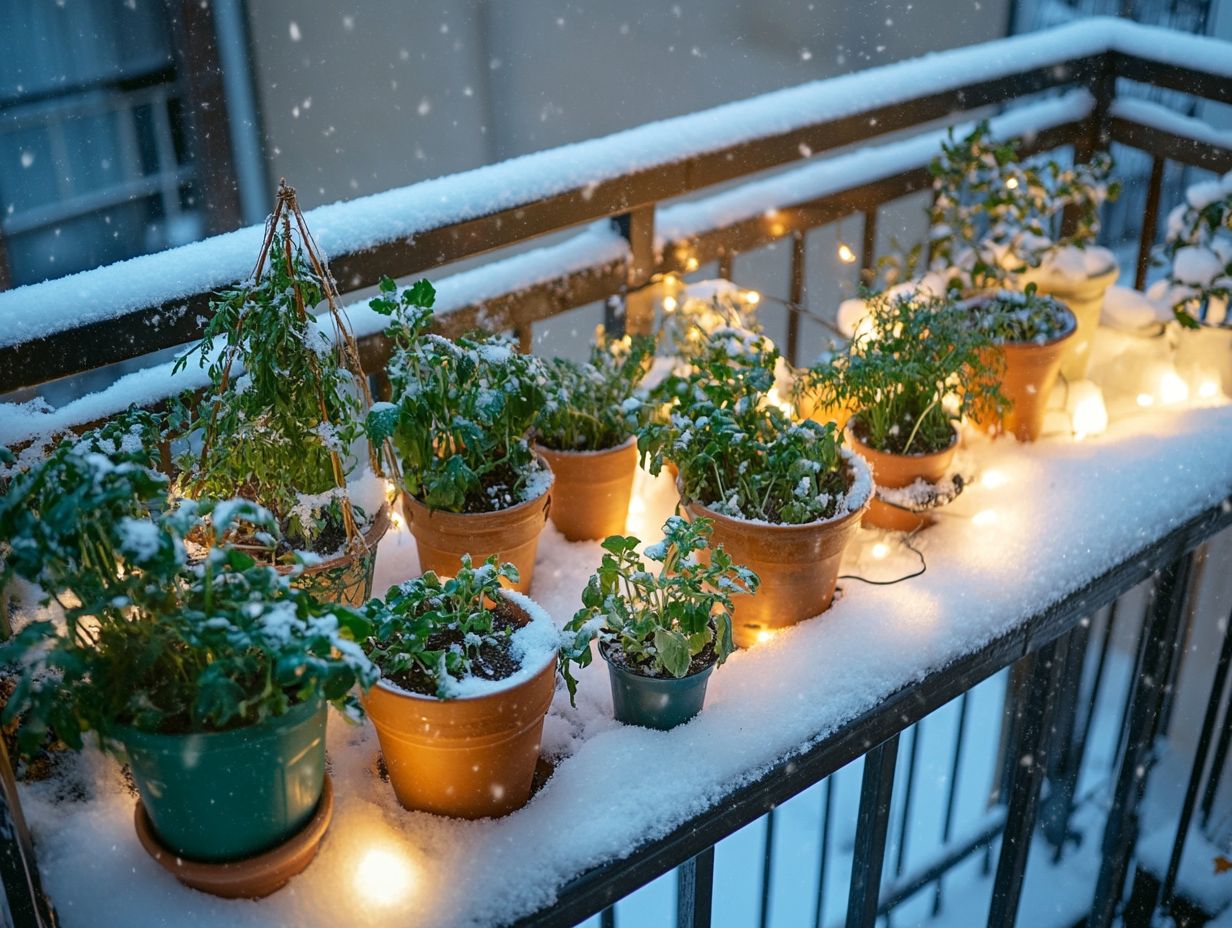
- Winter gardening brings a variety of benefits, including a sense of calm, fresh produce, and the opportunity to enjoy the outdoors even in colder months.
- For small spaces, winter gardening offers the advantage of utilizing limited areas efficiently and growing cold-hardy plants that thrive in compact settings, making it an excellent choice for urban gardening enthusiasts.
- Preparation, techniques, and harvest tips are key to successful winter gardening. Consider container, vertical, or indoor gardening and find creative ways to use your winter produce.
Benefits of Winter Gardening
Winter gardening presents a wealth of benefits that go far beyond simply growing food in the colder months. It enables you to cultivate a continuous supply of homegrown vegetables, fostering sustainable practices while ensuring you have access to fresh produce, even in challenging climates.
Embracing seasonal gardening enhances your family’s experience, teaching valuable skills in family gardening and instilling an appreciation for nature. This makes it an enjoyable and rewarding pursuit for all ages.
Winter gardening also encourages planting different types of crops in rotation, which helps improve soil health and maximizes your garden space for vegetable crops. This approach ultimately optimizes your yield, even during the frost-laden winter months, ensuring a sustainable gardening method.
Why Garden in the Winter?
Gardening in the winter can be a truly rewarding endeavor. It allows you to cultivate a variety of frost-tolerant crops that ensure a steady supply of homegrown vegetables, even when the chill of winter seems to put traditional gardening on hold.
By focusing on robust options like broccoli, kale, and Swiss chard, you can leverage their resilience against frost. These crops provide essential nutrition and a well-deserved sense of accomplishment.
These crops flourish even with shorter daylight hours, needing just a few hours of sunlight each day perfect for the winter months. To maximize your success, consider using cold frames or row covers to shield your plants from severe temperatures while keeping the soil wonderfully warm.
Regular watering and a layer of mulch can further boost growth, allowing you to relish fresh, vibrant produce exactly when it s most needed.
Advantages for Small Spaces
With limited garden space, winter container gardening presents a remarkable opportunity for you to cultivate fresh produce without the need for sprawling outdoor areas. This makes it an ideal solution for home gardening enthusiasts navigating urban landscapes.
By utilizing creative containers, such as repurposed wooden crates or elegant ceramic pots, you can transform your small balcony or patio into a lush green oasis. This approach not only maximizes your limited space but also invites personalization through DIY gardening projects, adding a unique charm to city living.
A variety of vegetables, including leafy greens like spinach and kale, thrive remarkably well in these compact settings. To ensure your gardening success, it s vital to select containers that are at least 12 inches deep and crafted from breathable materials like terracotta or fabric.
These choices will help regulate moisture levels while promoting robust root growth.
Choosing the Right Plants for Winter Gardening
Selecting the right plants for winter gardening is essential for achieving a bountiful harvest during the colder months. It requires a keen understanding of which cold-hardy varieties can thrive in low temperatures and withstand frost.
By focusing on these resilient options, you can enjoy a variety of nutritious produce, such as leafy greens, root vegetables, including carrots and beets, and cruciferous vegetables.
Cold Hardy Varieties
Cold-hardy varieties are your best allies for successful winter gardening. Think of options like broccoli, brussels sprouts, cabbage, and spinach. These crops showcase incredible resilience to low temperatures and provide you with nutritious harvests.
Not only can these crops withstand frost, but they often experience a flavor boost and increased sweetness after a freeze. This makes them a sought-after choice for gardeners passionate about winter produce. While optimal growing conditions can vary, these varieties generally flourish in well-drained soil rich in organic matter.
Timing is crucial. Aim for early fall planting to set yourself up for a full growing cycle before the coldest months hit.
Regular care is essential. Mulching helps keep soil warm and moist, which enhances growth and leads to bountiful yields throughout the chilly season.
Plants that Thrive in Limited Space

In urban areas, limited space shouldn’t stop you from gardening! Embrace container gardening to maximize yields while enjoying a delightful variety of vegetables and herbs for your culinary adventures.
Leafy greens like lettuce and spinach thrive beautifully in smaller containers. This allows for frequent harvests and continuous growth throughout the season. Meanwhile, herbs such as basil, cilantro, and parsley flourish in pots, providing fresh flavors that elevate your dishes.
When choosing containers, opt for materials like clay or plastic. Make sure they have proper drainage holes. The ideal size for these plants typically ranges from 5 to 10 gallons, depending on the depth of their roots.
Use vertical planting and layering to maximize your space, enabling you to cultivate a vibrant patch of greens right on your balcony or patio.
Preparing Your Garden for Winter
Prepare your garden carefully for winter. Begin with thorough cleaning and maintenance practices that protect your plants from frost and create optimal soil conditions for the colder months.
This preparation sets the stage for a thriving winter garden. It ensures that your efforts yield successful results when spring arrives and helps you plan your planting schedule.
Cleaning and Maintenance Tips
Cleaning and maintenance are crucial for your winter gardening. Start by thoroughly clearing away fallen leaves, debris, and weeds that might invite pests or diseases. This safeguards your healthy plants from potential threats.
To keep your garden flourishing, check for any lingering pests that could disrupt the harmony in the upcoming seasons. Don’t hesitate to employ natural pest control methods as needed.
Introducing high-quality soil amendments can significantly boost overall soil health. Composting not only recycles organic waste but also enhances the nutrient content vital for robust winter growth. This creates the perfect environment for resilient cooler climate crops.
Protecting Plants from Frost and Snow
To ensure your winter gardening efforts flourish, protecting your plants from frost and snow is essential. Techniques such as cold frames and greenhouses can significantly enhance the frost tolerance and survival rates of your winter crops.
These protective strategies foster a more favorable environment for growth and help manage temperature fluctuations that can stress your plants. Consider using row covers to provide an extra layer of insulation, which traps heat and shields your crops from biting winds.
Proper watering techniques are crucial during this season. Ensure your plants receive adequate moisture without becoming waterlogged. By regularly monitoring soil conditions and adjusting your watering schedules, you can avert frost damage and minimize plant stress.
Combining these protective measures will effectively support your healthy winter gardening endeavors.
Winter Gardening Techniques
Utilizing effective winter gardening techniques is crucial for maximizing your yield and nurturing plant growth during the colder months.
Techniques such as container gardening, vertical gardening, and indoor gardening offer innovative solutions for managing space and ensuring optimal plant care. By embracing these methods, you can create a thriving garden even when the temperature drops.
Container Gardening
Container gardening is a flexible technique. It allows you to grow different plants in small spaces.
Choosing the right container size is vital. Larger pots hold moisture longer, while smaller pots are great for drought-resistant plants.
The right potting soil is also important. It should drain well while keeping essential nutrients.
Tomatoes, peppers, and lettuce thrive in containers. They offer great yields and delicious flavors.
Use self-watering planters or create a watering schedule. This helps maintain the right moisture level.
Vertical Gardening
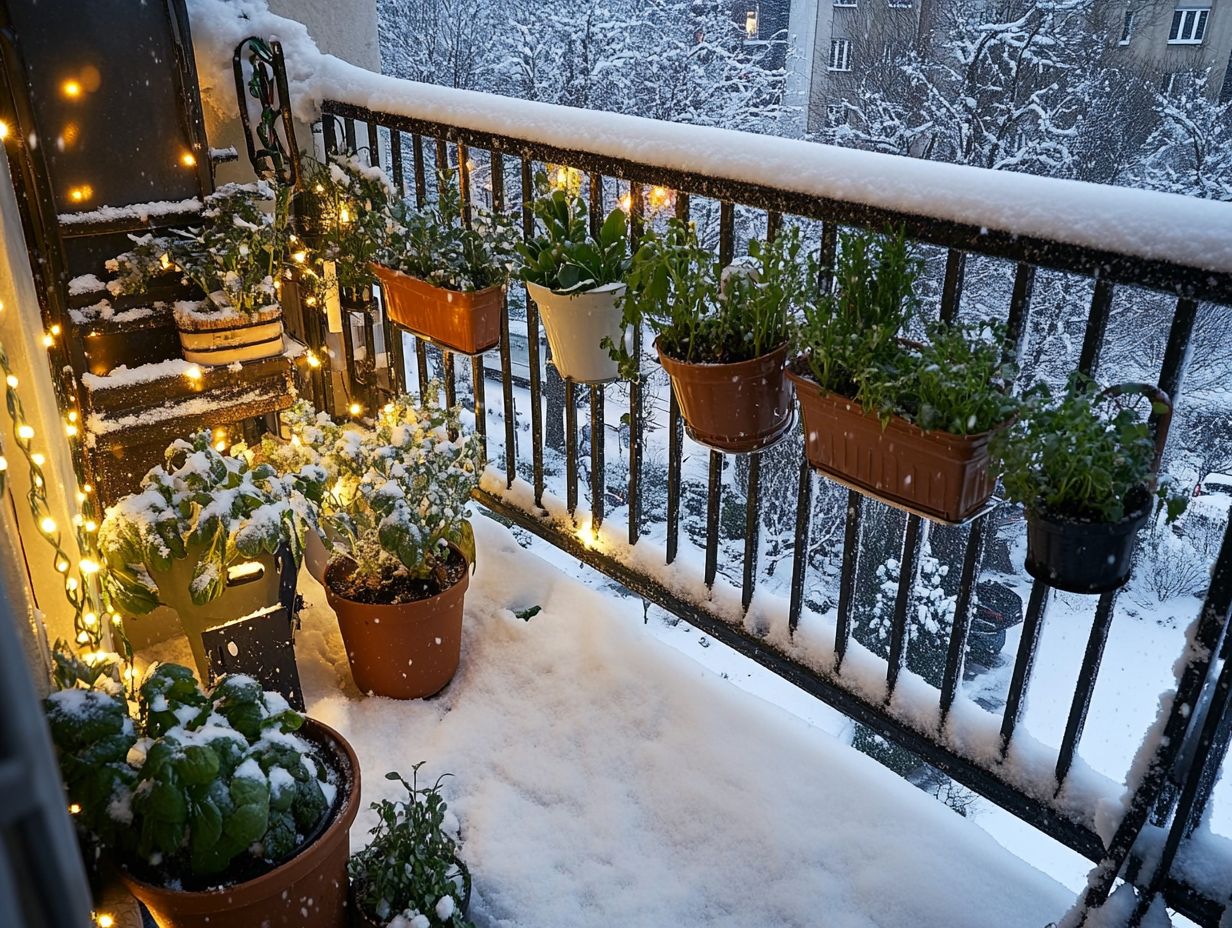
Vertical gardening turns small spaces into green havens. It allows you to grow climbing plants that enjoy sunlight and access nutrients.
This method is especially useful in winter. You can use trellises or vertical racks for plants like peas, beans, and leafy greens.
Incorporating insulated materials around your structures protects roots from frost. This helps your plants stay warm and healthy.
Indoor Gardening
Indoor gardening in winter opens up many opportunities. You can grow herbs and seasonal crops in a controlled space.
Understanding sunlight needs is crucial for success. Place herbs like basil and mint near south-facing windows for maximum light.
If natural light is low, consider grow lights. They help extend your growing season and keep plants vibrant.
Growing crops like lettuce and spinach indoors can be very rewarding. Regularly check humidity and temperature for healthy plants.
Harvesting and Storing Winter Produce
Harvesting and storing winter produce is an important part of winter gardening. By learning the right timing and preservation methods, you can keep your vegetables fresh all winter long.
Best Practices for Preserving Your Harvest
Employing best practices to preserve your harvest is essential for extending the shelf life of winter produce. Methods like freezing and canning serve as effective storage techniques that maintain quality and flavor throughout the seasons.
Understanding the nuances of each preservation method can significantly influence your results. Some vegetables thrive when frozen. Others maintain their taste and texture more effectively through canning.
For example, freezing captures the freshness of produce at its peak ripeness, resulting in a vibrant flavor profile. In contrast, canning offers a more concentrated taste but requires keeping things clean and ensuring the right acidity.
Grasping the stages of crop development allows you to pinpoint the best times to harvest, enhancing flavor while maximizing nutritional benefits. This knowledge makes the preservation process rewarding and beneficial for your health.
Tips for Enjoying Your Winter Garden
Enjoying your winter garden goes beyond mere harvesting; it invites you to explore inventive methods to incorporate winter produce into your cooking. It s also an opportunity to share the fruits of your labor through family gardening activities, fostering a deeper connection to the earth and each other.
Choose vegetables wisely to elevate your meals and truly savor the richness of the season, transforming the cold months into a culinary adventure.
Delicious Ways to Enjoy Winter Produce
Creatively utilizing winter produce can elevate your homegrown vegetables into delightful meals. A wealth of recipe ideas can showcase the unique flavors of seasonal crops like kale, carrots, and Brussels sprouts.
These vibrant ingredients not only add a splash of color to your plate but also present a wonderful opportunity to explore diverse culinary techniques. For example, when you incorporate kale into a hearty salad, massaging the leaves with olive oil can soften them and add flavor.
Similarly, a comforting soup featuring Brussels sprouts becomes even more delightful when you saut them first. This allows their natural sugars to caramelize and deepen the taste.
Experimenting with roasting or steaming carrots can also elevate their sweetness, transforming them into a delicious side or a flavorful base for stews. These methods not only highlight the vegetables goodness but also enhance their nutritional profiles, making each meal a celebration of winter s bounty.
Winter Gardening Activities for Small Spaces
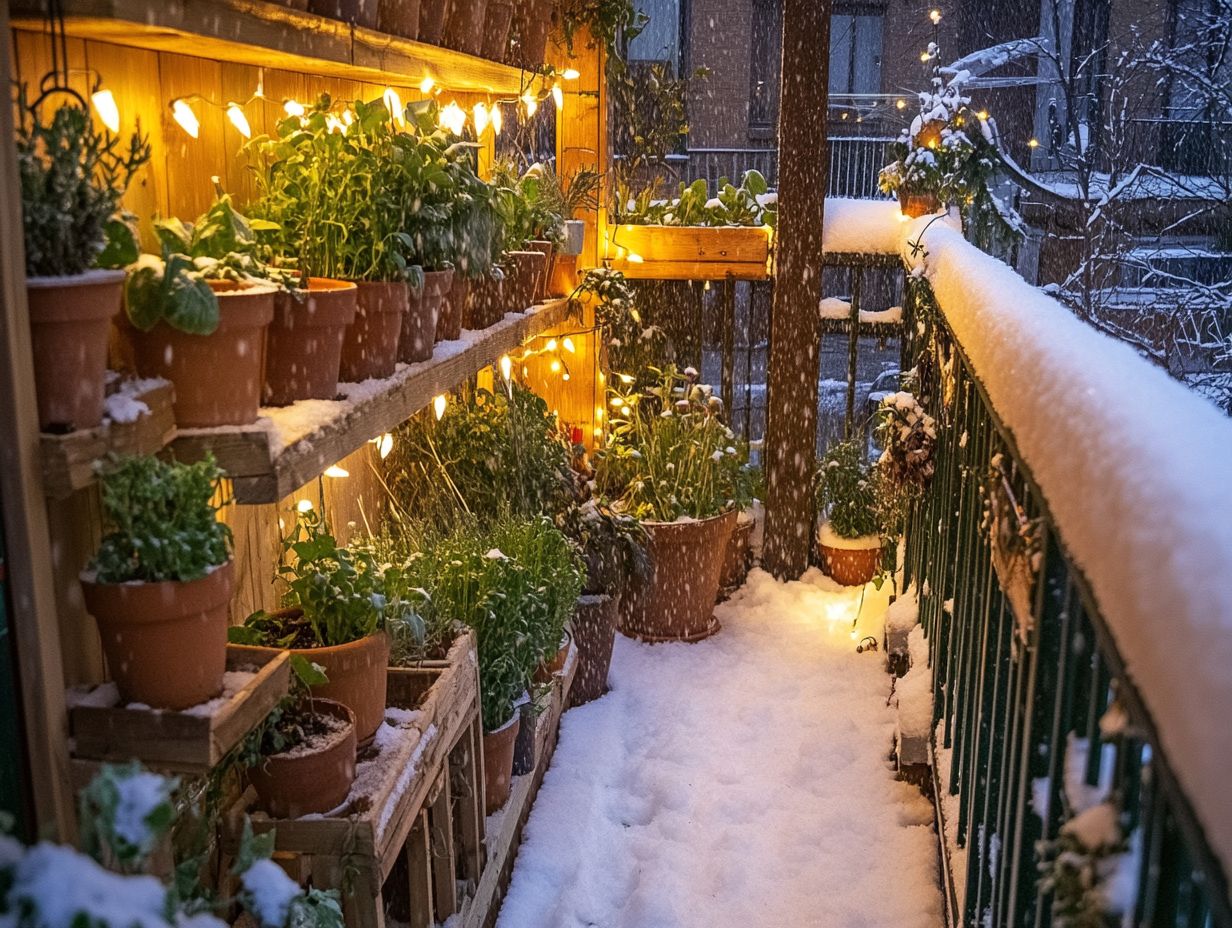
Engaging in winter gardening activities for small spaces can be incredibly rewarding for you and your family. It offers a unique opportunity to dive into container gardening and explore the nuances of growing seasonal crops, even in limited areas.
By starting seeds indoors, you can marvel at the transformation of tiny seeds into flourishing plants, nurturing a sense of responsibility. Planning themed vegetable plots introduces an element of creativity, encouraging collaboration and idea-sharing while maximizing your precious gardening space.
These activities teach you about the science of plant growth and strengthen family bonds through shared goals and teamwork. Whether you’re designing an herb garden or crafting a vibrant salad bowl, the joy of cultivating and harvesting together creates lasting memories, making your winter gardening moments truly special.
Frequently Asked Questions
What is winter gardening for small spaces?
Winter gardening for small spaces is the practice of gardening during the cold winter months in areas with limited outdoor space, such as balconies, patios, or windowsills. For those looking to enhance their skills, check out these winter gardening tips for enthusiasts.
Why should I try winter gardening for small spaces?
Winter gardening in small spaces lets you grow produce all winter long. It provides a way to add some greenery and life to your home during the winter.
What are some popular plants for winter gardening in small spaces?
Some popular plants for winter gardening in small spaces include kale, spinach, lettuce, herbs, and winter squash. These hardy plants thrive in colder temperatures.
Do I need any special equipment for winter gardening in small spaces?
You may need some basic gardening tools, like a small shovel or trowel.
Items such as plastic containers or window boxes can help create a garden space.
Consider using grow lights or a mini greenhouse to help your plants thrive.
How often should I water my winter garden in a small space?
The frequency of watering depends on the specific plants you are growing and your home’s conditions.
Check the soil moisture daily and water when the top inch of soil feels dry.
What are some tips for successful winter gardening in small spaces?
Choose hardy plants and ensure they get enough sunlight.
Keep the soil moist but don t overwater, and protect your plants from harsh weather.
Rotating your plants can enhance growth.
Try companion planting, which means growing different types of plants together for better success in your garden.


